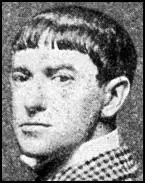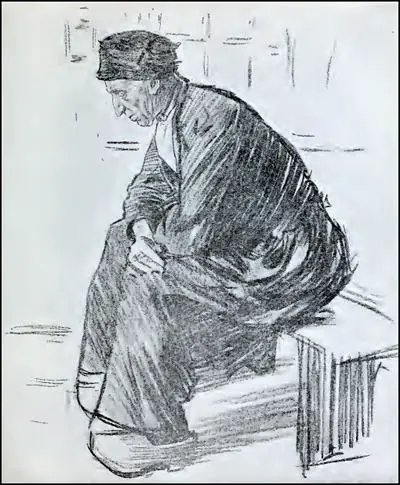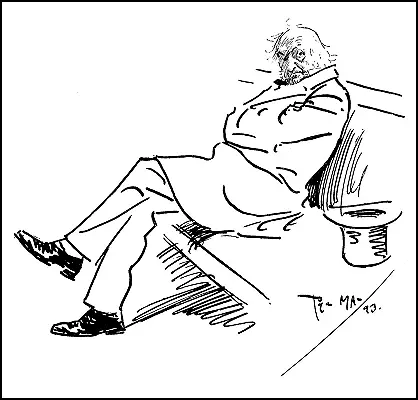Phil May

Phil May, the seventh child of Philip William May, an engineer, and his wife, Sarah Jane Macarthy, was born at New Wortley, near Leeds, on 22nd April 1864. When he was a young man his father had worked for George Stephenson. but being a poor businessman with a large family, fell on hard times. (1)
Philip William May died in 1873, at the age of fifty. "As the family was left without support, Phil May, who at his father's death was only nine years old, received very little schooling. He attended St George's School from 1872 to 1875, Oxford Place School from 1876 to 1877 and Park Lane Board School in 1877, but was sent to work before he was thirteen." (2)
Phil May joined a travelling troupe of actors and appeared at the Spa Theatre, Scarborough. However, he really wanted to be an artist. He moved to London but was unable to find work and eventually ended up sleeping on the streets and begging for money. Some of his first drawings were of other people living on the streets. (3)

Phil May eventually got work providing drawings for various publications. He also designed costumes for theatre companies. In 1885 he became a staff member of the St Stephen's Review and received a wage of £8 a week. "Political, theatrical and racing drawings, and even illustrations of ladies' costumes, formed most of this weekly work. Many of these, done under severe restrictions of time, were naturally lacking in composition and design, but, as the work of a youth twenty-one years old, they were all remarkable for fine portraiture." (4)
Phil May in Australia
Later that year May married an old Leeds friend, Lilian Emerson. Soon afterwards he met the Australian publisher W. H. Traill, managing director of the Sydney Bulletin. He accepted the offer of a job as a cartoonist at the newspaper at a salary of £30 a week for three years. May had been in poor health and the change of climate was considered to be beneficial. (5)
May found himself working with Livingstone Hopkins and Norman Lindsay. At the time the magazine was a nationalistic, irreverent and known throughout Australia as "the bushman's Bible". It was also a "stimulus and nursery for artistic talent". As one commentator has pointed out: "A famous cartoon marking Queen Victoria's funeral conveys something of its flavour: a drunk waits glumly outside a pub, closed for the day - the caption is The Nation Mourns." (6)
It has been estimated that over the next three years he produced about nine hundred drawings, cartoons, caricatures and jokes. According to one biographer, the three years spent at the magazine had an enormous effect on May and his future. "The compulsory and regular production of drawings may either by its monotony ruin an artist's work or, if he can maintain his enthusiasm and interest, greatly strengthen and improve it. In May's case the novelty of his surroundings, the confidence of an assured income and the constant intercourse with other artists, from whom he learned much, stimulated his powers and broadened his outlook... He was always experimenting with various methods and collecting knowledge and material which he often used in later years. After years of struggle and hardship he began to realize that his talents would now provide him with comfort and security. The Australian climate, with his improved conditions of life, contributed very favourably to an improvement in his health, which, never very robust, had been sadly affected by neglect and poverty." (7)
David Low later recalled that it was the work of May that inspired him to become a cartoonist. At first he studied the work of Charles Keene, Linley Sambourne and Dana Gibson. "The more I poured over the intricate technical quality of these artists the more difficult did drawing appear. How impossible that one could ever become an artist! But then I came on Phil May, who combined quality with apparent facility. Once having discovered Phil May I never let him go." (8)
The Daily Graphic
Phil May returned to London in 1890 and did some book illustrating until he met Harvey Thomas the son of William Luson Thomas, the owner and founder of The Daily Graphic. Thomas employed him on the newspaper, where he worked alongside, Sidney Sime, Alexander Boyd, Frank Brangwyn, Edmund Sullivan, Phil May, Leonard Raven-Hill, George Stampa, James H. Dowd, Bert Thomas and F. H. Townsend. In 1893 Thomas sent May on a tour round the world in company with E. S. Grew, a member of the literary staff. The tour ended at the Chicago World Fair. (9)
Edward Verrall Lucas has argued: "May's line at its best may be said to be alive. It is certain that no English draughtsman has ever attained greater vigour or vivacity in black and white." Percy V. Bradshaw, the author of The Art of the Illustrator (1918) agrees: "He surely gave more magic to a single line than any draughtsman who ever lived, and he was unquestionably the creator of the simplified technique of modern humorous drawing." May published a yearly Phil May Annual, and sold over 50,000 copies of each volume. (10)
Punch Magazine
Phil May began contributing cartoons to Punch Magazine in 1893 and two years later became a member of the staff. Mark Bryant has pointed out that May: "A very fast worker, he used models and was one of the first artists to make full use of the newly invented photographic (as opposed to wood-engraved) method of reproduction. For the Punch drawings he worked first in pencil and then drew over this in pen and ink." Bryant has suggested that "his uncluttered style had immense influence on later artists." (11)

May was a sociable character but unfortunately drank too much alcohol: "He hated pomposity and pretension, was direct in all his dealings, and very supportive of fellow artists.In appearance May was about 5 feet 8 inches tall, slight in build, and with the look of a jockey. This was emphasized by his sporting dress: breeches and loud check jackets, garments which featured frequently in his self-portrait drawings. Contemporaries referred to his fine features and delicate hands, but most memorable was the straight fringe of his black hair which cut across his forehead." (12)
One of those influenced by May was Cyril Bird: "He certainly had a greater effect on pictorial humour... than any other pictorial humorist or his or the following generation, and he showed the way for all the free and lively work which followed after him." William Rothenstein wrote: "He had a touchingly simple and affectionate character, but unfortunately he wasted himself and his means on a crowd of worthless strangers, who settled round his table like flies; while his terrible weakness for drink sapped his will and his physical strength." (13)
Although May's cartoons were rarely overtly political, he had a deep sympathy for the poor. Phil May had a unique style. He brought a new simplicity of line to popular cartooning. Not everybody understood his work and one editor asked: "Couldn't you finish up your drawings a bit more?"
A friend who knew him well wrote: "May was a man, in spite of all his faults and weaknesses, to whom one could not help being very much attracted. He was always gentlemanly in behaviour, had charming manners, was a very good talker on many subjects, very witty, and a great lover of music. I have seen him cross-grained, very, very depressed, and out of temper, but his charming manner never deserted him." (14)
Phil May was a heavy drinker. This and his early poverty caused him serious health problems. He suffered from a wasting disease and when he died of cirrhosis of the liver on 5th August, 1903, aged thirty-nine, he weighed only five stone.
Primary Sources
(1) James Thorpe, Phil May: Master-draughtsman & Humorist (1932)
In the autumn of 1885 a turning-point in his career arrived as a consequence of the visit to London of Mr W. H. Traill, managing director of the Australian Sydney Bulletin, who was in search of a cartoonist for that publication. Mr Traill obviously had an eye for a coming man, for May's work attracted his notice at once. He offered him a contract for three years at fifteen pounds a week, but this was not quite enough to tempt the rising young artist to uproot himself from London, break his newly formed connections, and exile himself to the opposite side of the world. The offer was increased to thirty pounds, and this tipped the balance. There is no doubt that considerations of health also had something to do with the decision. Since his illness he had worked hard, with little or no rest, and a sea-voyage promised well as a change and a tonic. The contract was signed, and May and his wife sailed for Australia on November 11th, 1885.
For the three years of the contract May worked strenuously and exclusively for the Bulletin, producing about nine hundred drawings, cartoons, caricatures and jokes. He and Rossi Ashton between them provided practically the whole of the illustrations required. Both he and his wife were extremely popular in Sydney, and May's humour, generosity, ability and modesty made him liked by everyone. Rumour has it that Traill, notwithstanding his recognition of May's talent, was somewhat uneasy about the appointment, even after the artist had definitely established his position with the Bulletin readers. He appears to have misunderstood the apparently effortless character of May's work, and, showing him an obviously more laboured drawing by another artist, asked, ‘Couldn't you finish up your drawings a bit--more like this?’ May's reply was characteristic. ‘When I can leave out half the lines I now use I shall want six times the money!’
The three years spent in Sydney had an enormous effect on May and his future. The compulsory and regular production of drawings may either by its monotony ruin an artist's work or, if he can maintain his enthusiasm and interest, greatly strengthen and improve it. In May's case the novelty of his surroundings, the confidence of an assured income and the constant intercourse with other artists, from whom he learned much, stimulated his powers and broadened his outlook. He formed a friendship with Blamire Young, the Australian artist, and used his studio at Katoomba College, NSW. He was always experimenting with various methods and collecting knowledge and material which he often used in later years. After years of struggle and hardship he began to realize that his talents would now provide him with comfort and security. The Australian climate, with his improved conditions of life, contributed very favourably to an improvement in his health, which, never very robust, had been sadly affected by neglect and poverty.
(2) Simon Houfe, Phil May : Oxford Dictionary of National Biography (2004-2014)
May had been an occasional Punch contributor from 1893 but was not elected to the staff until February 1895. The magazine had become very middle-class under Francis Burnand's editorship and May's raffish humour and concentration on low life was frowned on. It was his brilliant line and warm personality that won them over. After February 1895 May contributed to most numbers and almanacs. His inspiration came from the street, the music-hall, the boxing ring, and the gin palace; he was at home at racecourses, fairgrounds, or among bank holiday crowds, though seldom in the drawing-room. May was not a caricaturist, but descended from that distinguished group of illustrators including John Leech and Charles Keene who were illustrators of types. Humour lay was in the generic physiognomy of his drunks, landladies, publicans, and cabbies, not in their caricature.
(3) David Low, Autobiography (1956)
A pile of old copies of copies of Punch I found in the back room of a fatherly second-hand bookseller introduced me to the treasure of Charles Keene, Linley Sambourne, Randolph Caldecott and Dana Gibson. The more I poured over the intricate technical quality of these artists the more difficult did drawing appear. How impossible that one could ever become an artist! But then I came on Phil May, who combined quality with apparent facility. Once having discovered Phil May I never let him go.
